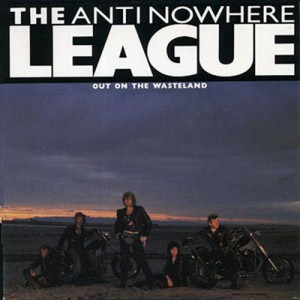Road to Nowhere: Mad Max: Fury Road and the Unstoppable Safe Transgressions of Cult Cinema
Post by Ernest Mathijs, University of British Columbia
Mad Max: Fury Road (Miller, 2015) never stops. As befits an action film, it has a kinetic drive, fast momentum, frenetic movement, high horizontal speed, and moves in a singular direction: straight, in every sense of the word. A simple run from point A to point B and back, non-ironic, not overly serious or complicated, its action solidly centered in the frame, and its pace accelerated to an average of 22.5 cuts per minute (with nary a shot at a regular 24 frames-per-second), Fury Road razes everything in its path–checkpoints, landmarks, or fellow travelers. In fact, Fury Road is so obsessed with linear directions that the rag tag gang of (mostly) women that is escaping the Citadel to look for the Green Place, pass right by it, then realize their supposed dream place is a dead swamp and decide to return, with the same breakneck velocity and via the same route, to their point of departure: the Citadel–back to where they came from, to seek vindication.
As straight as Fury Road‘s narrative is, so swerving are its meanings or themes. Yet, here too, the film bulldozes through whirlwinds of implications the same way Max (Tom Hardy) and Imperator Furiosa (Charlize Theron) crash across the flat, desolate wasteland–with a certain disregard for the finer points of debate or thoughtfulness, and without really hooking onto one particular ideology or philosophy. In doing so, I argue, Fury Road offers, like so much of cult cinema, safe transgressions–as if passing by a car crash site with one eye on the wheel and one on the wreckage. In this short essay I hope to show that Fury Road‘s solid credentials as a cult film, which it already seems to acquire the following of even within the first few months of its release, may well help audiences reach insights more radical or revolutionary than what regular normative and conformist film fare prompt them to. But, those same cult credentials also prevent Fury Road from being recruited as a progressive film and simultaneously save it from being recuperated as only a reactionary, mindless blockbuster.
The term “safe transgression” was coined by Barry Keith Grant (1991). In a seminal essay on the ideological function of cult movies, Grant argued that many cult films appeared to promise revolutionary ideals or instigations, prodding viewers to not only accept the revelations and expositions they proposed (capitalism kills you, gender fluidity is liberating, the world is going to hell, …) but also act upon them and do something about it. Yet, Grant noticed, such actions rarely occurred. Viewers did not start a revolution after seeing Night of the Living Dead, El Topo, The Rocky Horror Picture Show, or Mad Max, a film he used as a recurrent example. “Cult films encourage viewers not to take very seriously the threat of the Other,” concludes Grant (135).
At first glance, this conflicts with the debate surrounding Fury Road, which is typified by a high degree of action- and involvement-driven words. Angry initial reactions and calls for a boycott came from so-called men’s rights activists (MRA), self-proclaimed keepers of the flame of masculinity as represented in, amongst others, action films, because there wasn’t enough “guy stuff” in the film have been followed by furious discussion pieces that argue Fury Road is a powerful feminist intervention in genre film and/or a manifesto for radical egalitarianism, or a Marxist exposure of the superstructure of our society’s addiction to gasoline (or guzzoline, to use Fury Road‘s vocabulary), and that, if one adds just a little dose of provocation to these arguments (a little “spray,” to speak with the film’s lexicon of liquids), Fury Road is a call to arms: for equality, women’s lib, or against homosexuality. And you know what? I do think the film is actually all of these, and then some. But also, to paraphrase masculine punk rock band Anti-Nowhere League, not known for their feminist stance: “so what?”
Why “so what”? Because there are so many little indicators that Fury Road is riding the road Grant outlined, of claiming a warrior purpose by transgressing society’s ideology through harsh imagery and language (more imagery than language in this dialogue-sparse film) of that ideology’s violent and arbitrary power base, all the while undermining that purpose, or at least offering enough moments of ambiguity, that any straightforward interpretation becomes “just talk,” one of many possible perspectives that it might as well not be purposeful at all, but rhetoric, circumstance, or incidence, one of dozens of reading protocols.
These indicators and ambiguities are perhaps best encapsulated by the double-necked, heavily adorned electric glam guitar-annex-flamethrower, catapulting itself at the viewer at the close of the film. Even if we accept that the poor guy playing the guitar during the desert chases, tied to a wall of amps, dressed in a red suit (dare we describe it as flaming red?) with a brown leather mask, was a slave, forced to riff a soundtrack to Immortan Joe’s (Hugh Keays-Byrne) army as they battle Furiosa and Max and company, the visual is so coded with hyperbole and camp sensitivity, so easily linked into a convoy of references from Phantom of the Paradise to This Is Spinal Tap, that it layers the scene so thickly it robs it from any “true” transgressive functions–if there were any.
Other examples abound. To be clear, we are not talking here about the extravagant wardrobe, the masks, the overly comic-y names (Vuvalini, Rictus Erectus), or the cars that are a mockery of “muscle cars.” All of these can be seen as fitting a “message” or “function.” Less easily tied into straightjacketed understandings, and therefore working against them, and offering safe transgression instead, is, for instance, the exploitation imagery of the slave wives Furiosa is helping escape. Clad in torn, revealing, white loincloth and tops, the film presents them equally as empowered (warrior women) and exploited (women in prison, to link it to one exploitation genre). But in the strings of references they conjure they are much more: Emmanuelle as much as Khaleesi, but also, with a slightly different looking chastity belt, Ursula Andress’ Honey Rider from Dr. No–as much a feminist provocation to as a satisfaction of patriarchal oppression, and then some.
Or consider the loose use of freakery and disability, notably present with both the “good” and “bad” sides in the story, such as the shot that lingers just a second too long on a legless man to not see the wink to El Topo or Freaks; or the use of programmed “disgusting” moments, such as Nux (Nicholas Hoult) eating a bug (Tom Waits, anyone?). Honestly, when I saw the first chainsaw appear in Fury Road, I laughed out loud. As Mark Kermode (1997) explained, ever since The Texas Chainsaw Massacre, and definitely since Evil Dead, Motel Hell, American Psycho and–why not–Sharknado, one cannot just produce a chainsaw on screen anymore without knowing the viewer is likely to click into an endless rapids of connections, some trivial, some not. Such moments of surplus meaning take away any transgressive power the film might otherwise have. Too bad there wasn’t a rabbit–though Mad Max 2: The Road Warrior has one.
Most of the commentators mentioned earlier in this essay refer to symbols, such as the fluids gasoline and breast milk (the first themed masculine, the second feminine), as support for Fury Road‘s aims as a political film without taking into account an entire body of knowledge–knowledge that viewers possess readily–about the representations of bodily fluids (yes, gas is turned into a bodily fluid here more than once) as “safe-transgressive” props in cult cinema. Fury Road is cult-by-numbers, and therefore one doesn’t have to do anything with the symbols and metaphors it puts forward–we see them, smile, add more, move on, and never stop.
 Against orthodox thought on cult films, which holds a film has to earn its cult status through a lengthy reception trajectory, Fury Road is always already a cult film. It had an obvious built-in cult potential, as many fans and commenters have observed. And not just because its predecessors Mad Max and The Road Warrior had become cult films, but precisely because these films were accepted as cult much earlier on in their reception trajectory than other cults. When Danny Peary included Mad Max in his classic overview Cult Movies in 1981, the film was less than two years in circulation. And Peary readily added The Road Warrior in the third edition of Cult Movies. Not one other franchise was given such preferential treatment. With this legacy, Fury Road simply has to be considered within the framework of cult cinema. In that framework, safe transgression is an unstoppable operative, driving more unilateral interpretations off the road. That doesn’t mean we can’t like the film. I did, a lot. But to ignore safe transgression is to misunderstand Fury Road.
Against orthodox thought on cult films, which holds a film has to earn its cult status through a lengthy reception trajectory, Fury Road is always already a cult film. It had an obvious built-in cult potential, as many fans and commenters have observed. And not just because its predecessors Mad Max and The Road Warrior had become cult films, but precisely because these films were accepted as cult much earlier on in their reception trajectory than other cults. When Danny Peary included Mad Max in his classic overview Cult Movies in 1981, the film was less than two years in circulation. And Peary readily added The Road Warrior in the third edition of Cult Movies. Not one other franchise was given such preferential treatment. With this legacy, Fury Road simply has to be considered within the framework of cult cinema. In that framework, safe transgression is an unstoppable operative, driving more unilateral interpretations off the road. That doesn’t mean we can’t like the film. I did, a lot. But to ignore safe transgression is to misunderstand Fury Road.







